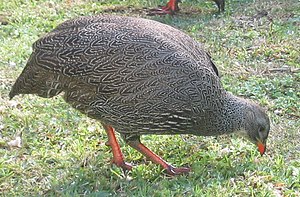Francoline
| Francoline | ||||||||||
|---|---|---|---|---|---|---|---|---|---|---|

Cape Frankolin , Francolinus (Pternistis) capensis |
||||||||||
| Systematics | ||||||||||
|
||||||||||
| Scientific name | ||||||||||
| Francolinus | ||||||||||
| Stephens , 1819 |
The Frankoline ( Francolinus ) are a genus of the family of pheasant-like (Phasianidae) located in the four sub-genera, Francolinus, Peliperdix , Scleroptila and Pternistis divided, some of which are also viewed as a separate species. With 41 species, the Frankoline are the most species-rich genus of the pheasant-like. 36 species live in Africa, five species occur in Asia. There is still a lack of basic information about many of the francolin species. Both in Africa and Asia , francolin are hunted intensely because of their tasty meat.
Appearance
Francolines look similar to the partridge , but they are slimmer than these and the beak and head are longer. The body length is between 31 cm and 42 cm, their weight varies from just under 250 g ( Coquifrankolin ) to over 1,500 g ( Erckelfrankolin ). Males and females are colored the same in most species, with the males mostly having spores on their strong legs. Its wings are short and rounded at the ends, and the tail has 14 control feathers .
distribution
Francoline live in the tropical regions of Africa and Asia . Its northern limit of distribution is around the Caucasus . The numerous Frankolin species adapt very flexibly to human settlements and cultural landscapes , so that the habitats are very different depending on the region: Dense forests or open grassland , wooded fields or bush landscapes , even stony karst areas offer the Frankolines food and protection. Of 41 living species, 36 are found exclusively in Africa. Of the 36 species of francolin that occur in Africa, 12 live in southern Africa , seven of them in Namibia , including the hard- leaf francolin , the red-billed francolin and the partridge francolin . The Cape Frankolin , which lives scattered in the Cape provinces of South Africa , also occurs occasionally in southern Namibia. A fossil Francolin , Francolinus capeki , found in Hungary , could be dated to the late Pliocene (about 1.8 million years ago).
Way of life
They live mainly on the ground and feed on insects , plants and seeds . Even in the event of danger, which the males announce with loud and harsh voices, usually from the hills, the francolin usually always bring themselves to safety. Some species retreat into trees with dense foliage only to sleep. Many francolines are distinct territorial birds and fight bitter fights in their defense, especially during courtship . They live in monogamy . It only incubates the female for up to 23 days while the male watches nearby. The nest usually consists of a flat hollow covered by tall grass or drooping twigs, which is laid out with grass and twigs. The clutch comprises six to 12 eggs , depending on the species . The young birds are so-called nest fleeing . They leave the nest a few days after hatching under the guidance of their parents, with whom they live in the family for six to twelve months .
species





- Subgenus Francolinus (5 species)
- Black francolin ( Francolinus francolinus )
- Chinese Francolin ( Francolinus pintadeanus )
- Marsh frankolin ( Francolinus gularis )
- Drip frankolin ( Francolinus pictus )
- Gray Francolin ( Francolinus pondicerianus )
- Subgenus Peliperdix (5 species)
- Coquifrankolin ( Francolinus coqui )
- Schlegelfrankolin ( Francolinus schlegelii )
- Schopffrankolin ( Francolinus sephaena )
- Forest Frankolin ( Francolinus lathami )
- White-throated frankolin ( Francolinus albogularis )
- Subgenus Scleroptila (7 species)
- Finschfrankolin ( Francolinus finschi )
- Gray-winged frankolin ( Francolinus africanus )
- Highland Frankolin ( Francolinus psilolaemus )
- Collared frankolin ( Francolinus streptophorus )
- Partridge Frankolin ( Francolinus levaillantoides )
- Red-winged frankolin ( Francolinus levaillantii )
- Shelleyfrankolin ( Francolinus shelleyi )
- Subgenus Pternistis (23 species)
- Ahantafrankolin ( Francolinus ahantensis )
- Bamboo frankolin ( Francolinus jacksoni )
- Brown-necked frankolin ( Francolinus castaneicollis )
- Clappertonfrankolin ( Francolinus clappertoni ), now Pternistis clappertoni
- Double- spurred frankolin ( Francolinus bicalcaratus )
- Edelfrankolin ( Francolinus nobilis )
- Erckelfrankolin ( Francolinus erckelii )
- Yellow-throated Frankolin ( Francolinus leucoscepus )
- Yellow-billed francolin ( Francolinus icteorhynchus )
- Graubrustfrankolin ( Francolinus rufopictus )
- Gray stripe frankolin ( Francolinus griseostriatus )
- Hartlaubfrankolin ( Francolinus hartlaubi )
- Harwoodfrankolin ( Francolinus harwoodi )
- Hildebrandtfrankolin ( Francolinus hildebrandti )
- Cameroon Frankolin ( Francolinus camerunensis )
- Cape Frankolin ( Francolinus capensis )
- Natalfrankolin ( Francolinus natalensis )
- European red-throated frankolin ( Francolinus afer )
- Red-billed francolin ( Francolinus adspersus )
- Schuppenfrankolin ( Francolinus squamatus )
- Swainsonfrankolin ( Francolinus swainsonii )
- Swierstrafrankolin ( Francolinus swierstrai )
- Juniper Frankolin ( Francolinus ochropectus )
supporting documents
literature
- Steve Madge , Phil McGowan, and Guy M. Kirwan : Pheasants, Partridges and Grouse. A Guide to the Pheasants, Partridges, Quails, Grouse, Guineafowl, Buttonquails and Sandgrouse of the world. Christopher Helm, London 2002, ISBN 0-7136-3966-0 .
Web links
- Francolin & Partridge - Aviculture & Conservation
- Francolin videos on the Internet Bird Collection
- World Bird Guide - Pheasants
- Changes in the generic names of the pheasant-like species
- Avibase - Bird Control List of the World - Africa - Pheasants
Single receipts
- ↑ Pheasants, partridges & fran colins in the IOC World Bird List
- ↑ Madge et al., P. 192